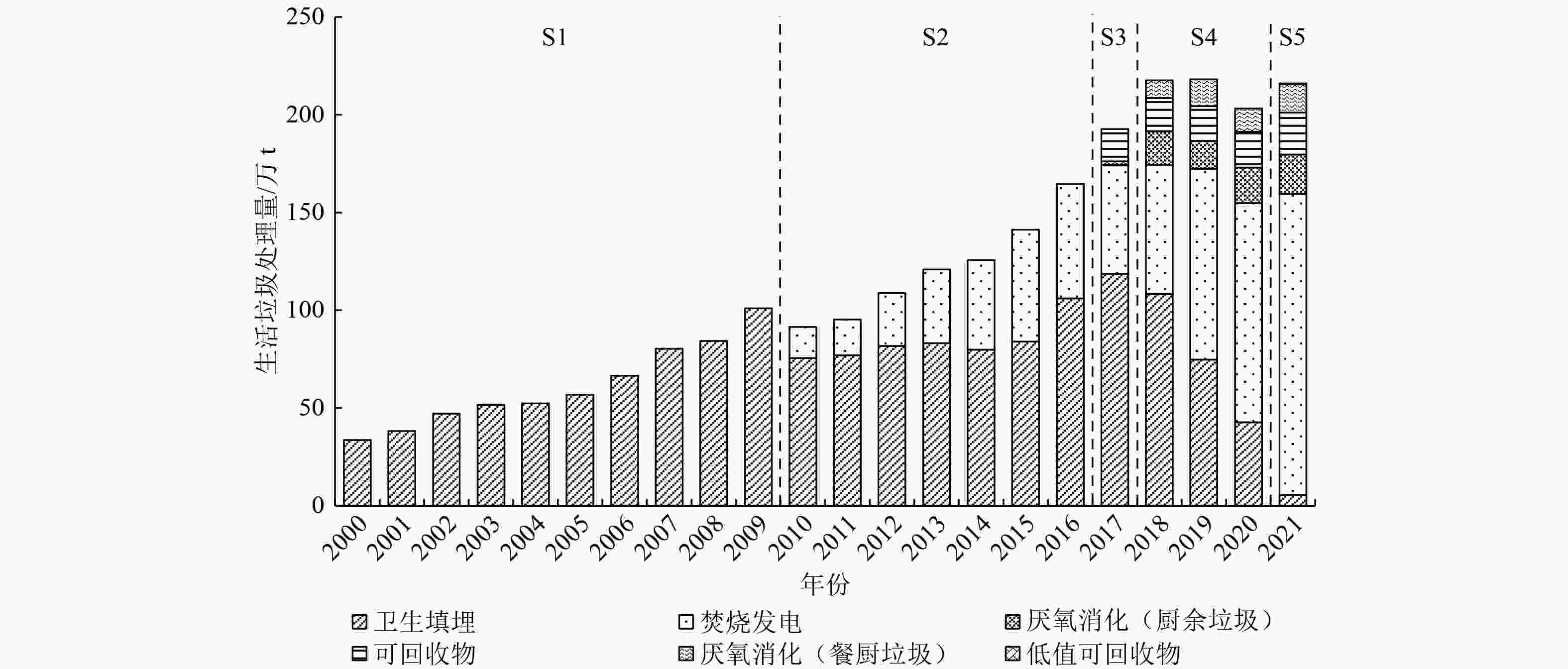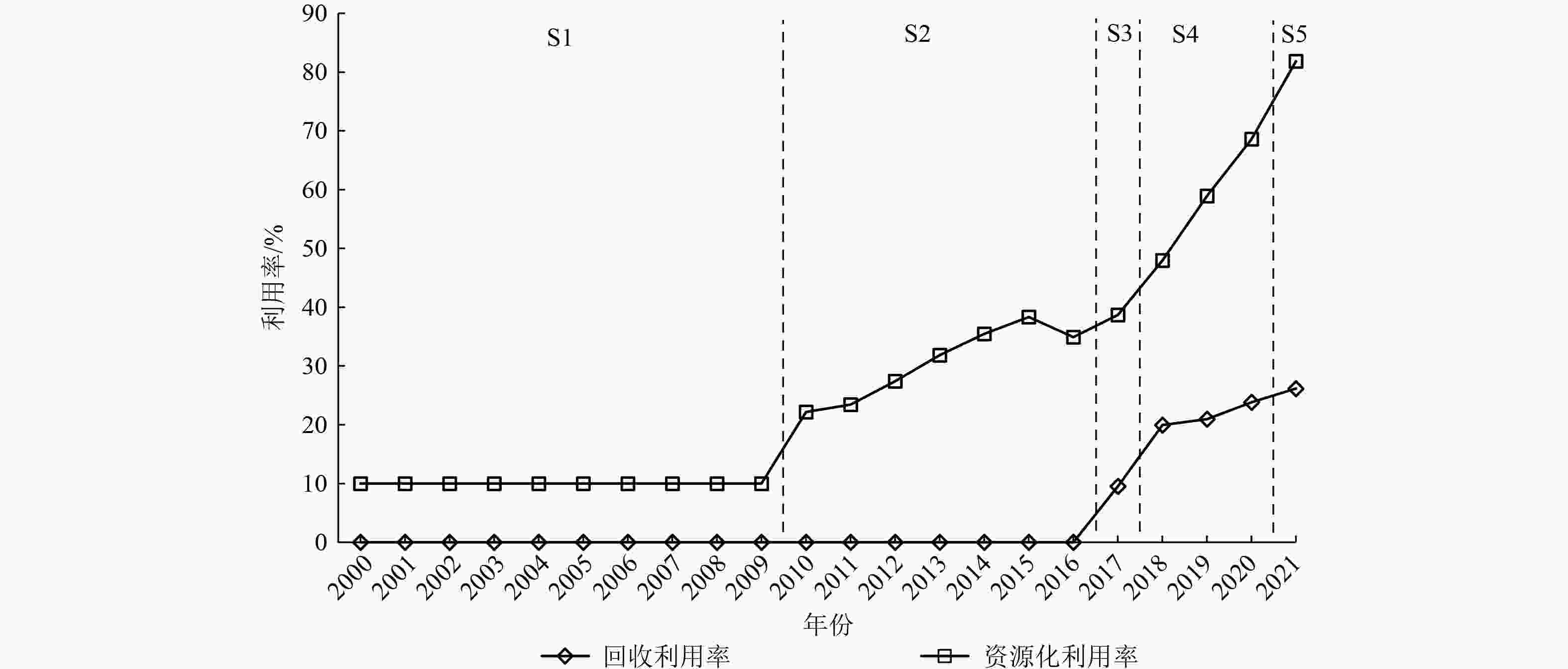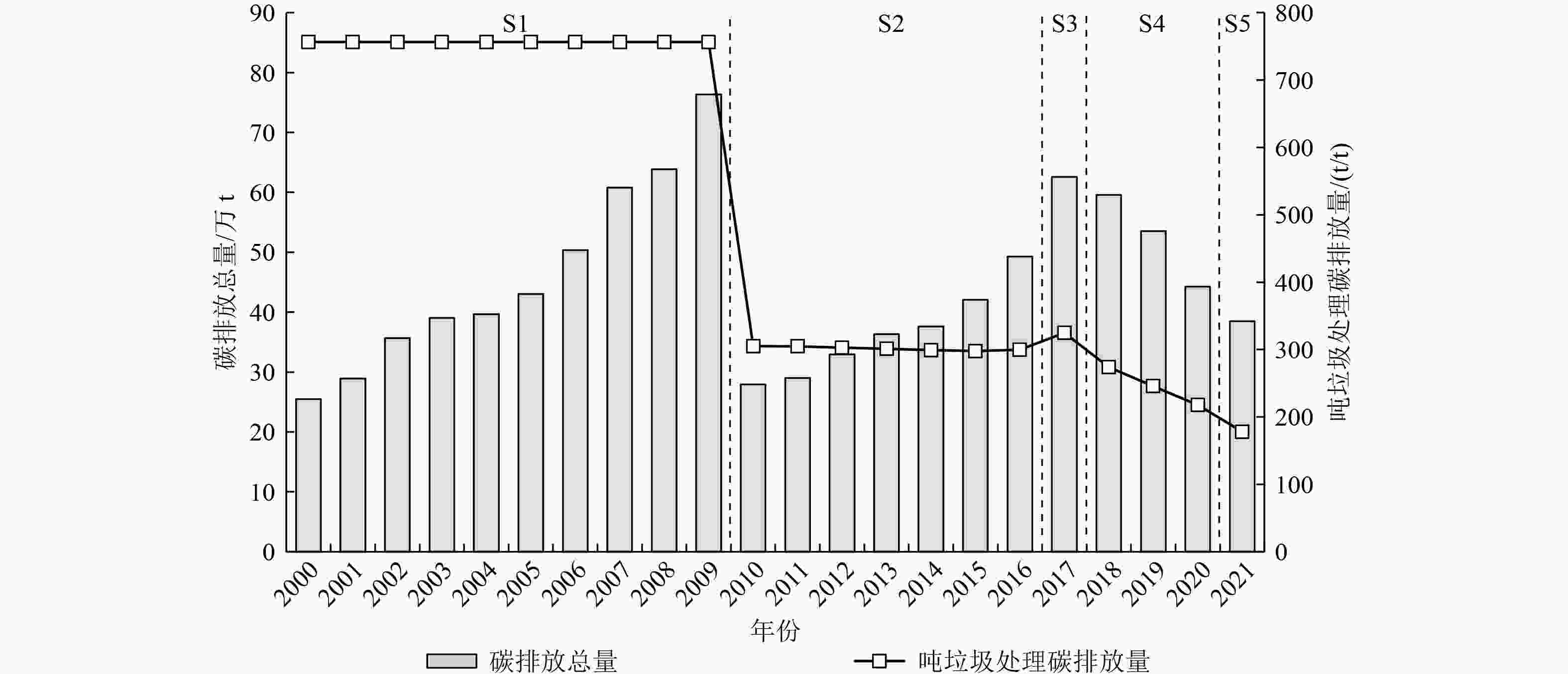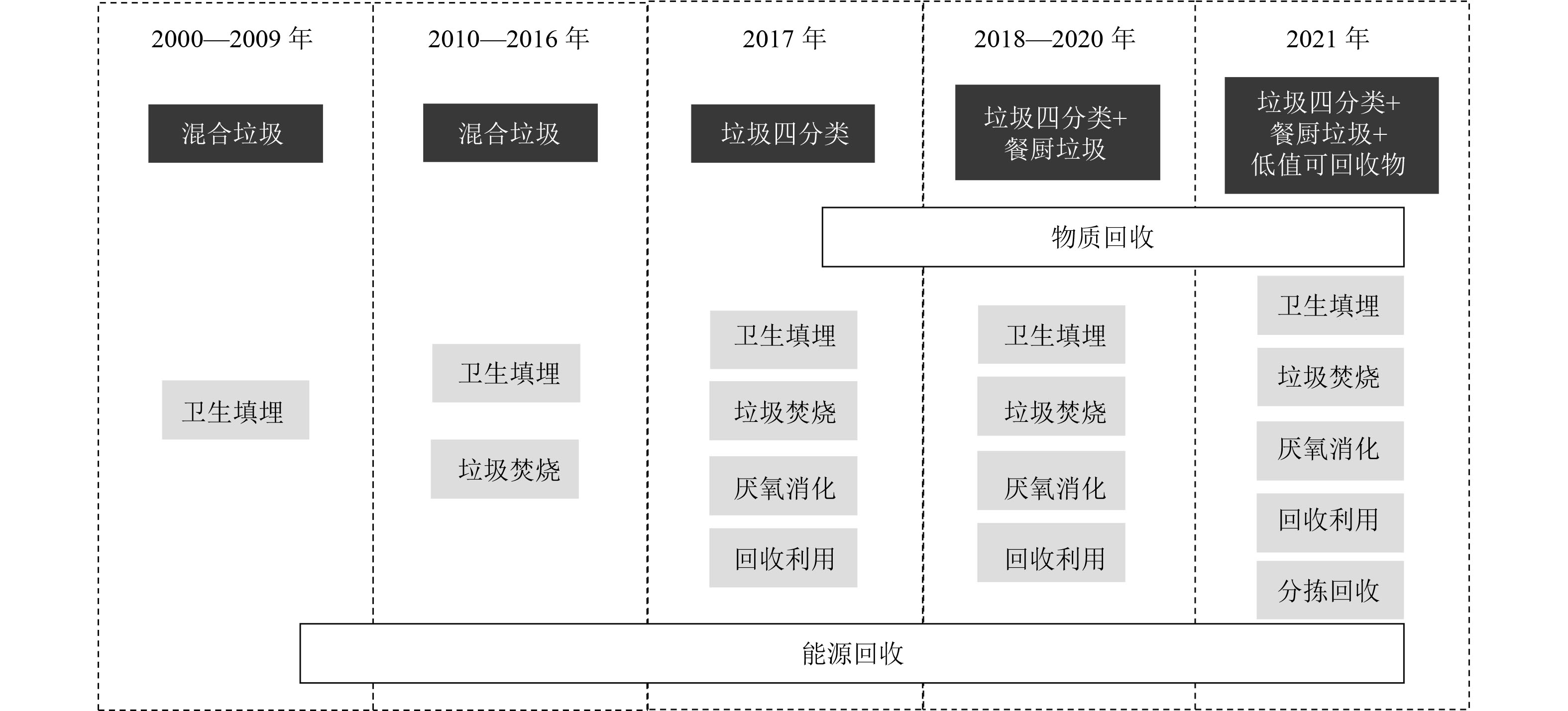Carbon emission reduction potential of municipal solid waste treatment and disposal at different management stages: a case study of Xiamen City
-
摘要:
我国快速城市化带来了大量的城市生活垃圾。为了破解“垃圾围城”的普遍性难题,我国不断完善生活垃圾管理体系,经历了以填埋为主的无害化、以焚烧为主的无害化和减量化、垃圾强制分类在全国主要城市的全面推广、分类垃圾综合处理处置等不同发展阶段。以厦门市为例,分析不同生活垃圾管理阶段的碳排放特征。结果表明:厦门市2000—2009年(无害化阶段)的碳排放总量由25.49万t直线上升至76.38万t,年均增长13.19%;2010—2016年(无害化和减量化阶段)由于填埋气收集效率提升和持续推进垃圾焚烧减量,吨垃圾碳排放强度逐年下降,但排放总量仍然从27.95万t增长至49.30万t;2017年至今全市推行垃圾四分类并开展餐厨垃圾分类和低值可回收物试点,碳排放强度从324.74 kg/t下降至178.11 kg/t,其中每分出1 t厨余垃圾、可回收物、餐厨垃圾和低值可回收物,碳排放分别减少5.69、302.58~328.75、83.19、884.66 kg。未来,随着低值可回收物分类和再生资源中心建设的推广,生活垃圾碳排放总量和强度将进一步降低,推动城市绿色低碳发展。
Abstract:The rapid urbanization has generated a large amount of municipal solid waste (MSW) in China. In order to address the universal issue of garbage siege, China continues to improve the MSW management system. It has undergone different stages of development, such as landfill-based harmlessness, incineration-based harmlessness and reduction, comprehensive promotion of compulsory classification of garbage in major cities, and the comprehensive treatment and disposal of classified garbage. Taking Xiamen City as an example, the carbon emissions and characteristics of different MSW management stages were studied and analyzed. The results showed that the total amount of carbon emissions in Xiamen from 2000 to 2009 (harmlessness stage) increased from 254 900 t to 763 800 t, with an average annual growth of 13.19%. From 2010 to 2016 (harmlessness and reduction stage), the carbon emission intensity per ton of waste decreased each year due to the improvement of landfill gas collection efficiency and the continuous promotion of waste incineration reduction. However, the total emissions still increased from 279 500 t to 493 000 t. Since 2017, the city has implemented the four classifications of garbage, carried out the classification of kitchen waste, and built a pilot project for low-value recyclables. The carbon emission intensity has decreased from 324.74 kg/t to 178.11 kg/t, and the carbon emissions per ton of food waste, recyclables, kitchen waste and low-value recyclables were reduced by 5.69, 302.58-328.75, 83.19, and 884.66 kg, respectively. In the future, with the promotion of low-value recyclables classification and the construction of renewable resource centers, the carbon emission intensity and total amount of domestic waste will be further reduced, promoting the city's green and low-carbon development.
-
表 1 不同场景涉及的碳排放源识别
Table 1. Identification of carbon emission sources involved in different scenarios
碳排放形式 S1 S2 S3 S4 S5 直接排放 填埋场CH4排放;渗滤液处理CH4和N2O排放 填埋场CH4排放;垃圾焚烧CO2排放;垃圾焚烧处理CH4和N2O排放;渗滤液处理CH4和N2O排放 填埋场CH4排放;垃圾焚烧CO2排放;垃圾焚烧处理CH4和N2O排放;厌氧消化CH4泄漏;渗滤液/沼液处理CH4和N2O排放 填埋场CH4排放;垃圾焚烧CO2排放;垃圾焚烧处理CH4和N2O排放;厌氧消化CH4泄漏;渗滤液/沼液处理CH4和N2O排放 填埋场CH4排放;垃圾焚烧CO2排放;垃圾焚烧处理CH4和N2O排放;厌氧消化CH4泄漏;渗滤液/沼液处理CH4和N2O排放 间接排放 处理处置物质输入;处理处置电量输入 处理处置物质输入;处理处置电量输入;飞灰/炉渣处理 处理处置物质输入;处理处置电量输入;飞灰/炉渣处理 处理处置物质输入;处理处置电量输入;飞灰/炉渣处理 处理处置物质输入;处理处置电量输入;飞灰/炉渣处理 碳存储 填埋气回收 填埋气回收;焚烧发电 填埋气回收;焚烧发电;沼气利用;可回收物利用 填埋气回收;焚烧发电;沼气利用;粗油脂回收;可回收物利用 填埋气回收;焚烧发电;沼气利用;粗油脂回收;可回收物;低值可回收物利用 表 2 城市生活垃圾填埋/焚烧参数取值[16]
Table 2. Parameter values of landfill and incineration of MSW
% 垃圾组分 DOCi Ci Fi 厨余类 15 50 纸类 40 50 5 塑料类 85 100 纺织类 24 50 50 木竹类 43 54 表 3 进入填埋/焚烧系统中的城市生活垃圾物理组分占比
Table 3. Proportion of MSW physical components entering the landfill and incineration system
% 场景 厨余类 纸类 塑料类 橡胶类 金属 玻璃 纺织类 木竹类 其他 S1 59.31 3.48 11.18 0.53 0.61 1.84 1.87 1.32 19.86 S2 55.37 5.14 19.18 1.86 0.63 1.30 1.76 1.98 12.78 S3 20.31 22.82 24.59 5.52 5.92 6.27 6.63 7.94 S4 21.20 22.33 24.42 5.61 5.23 5.83 6.90 8.48 S5 20.38 23.23 24.01 5.63 2.92 4.70 6.39 8.11 4.63 表 4 生活垃圾处理过程中间接碳排放涉及的参数及排放因子
Table 4. Parameters and emission factors involved in indirect carbon emissions in the process of domestic waste treatment
处理方式 清单名称 消耗量 排放因子/
(kg/kg)数据来源 填埋 柴油 1.05 kg/t 3.15 文献[23-24] 农药 0.02 kg/t 13.50 文献[24-25] HDPE膜 1.04 kg/t 3.27 文献[23-24] 电能 2.61 kW·h/t 0.58 文献[25-26] 焚烧 柴油 0.39 kg/t 3.15 文献[24-25] NaOH 0.05 kg/t 1.59 电能 9.38 kW·h/t 0.58 厌氧消化 柴油 3.00 kg/t 3.25 文献[24-25] Fe2O3 0.83 kg/t 1.1 文献[24,27] 电能 16.46 kW·h/t 0.58 文献[26-27] 废水处理 PAC 0.71 kg/m3 22.70 文献[28-29] NaOH 0.11 kg/m3 1.59 文献[24,28] 电能 1.93 kg/m3 0.58 文献[26,28] 低值
可回收物
分拣回收预处理 电能 7.80 kW·h/t 0.58 实地调研
文献[26]分拣 电能 37.00 kW·h/t 0.58 打包 电能 16.80 kW·h/t 0.58 注:电能排放因子单位为kg/(kW·h)。 纸类 塑料 织物 金属 玻璃 家电及电子产品 −0.120 −1.024 −3.376 −3.577 −0.314 −0.853 表 6 厦门市2000—2021年垃圾清运量与经济社会情况
Table 6. MSW clearance volume and economic and social situation in Xiamen City from 2000 to 2021
年份 年垃圾总量/(万t/a) 垃圾日产量/(t/d) 垃圾增长率/% 常住人口数/万人 人均垃圾产量/
〔kg/(人·a)〕地区生产总值/亿元 单位地区生产总值垃圾
产量/(kg/万元)2000 33.68 922.87 205 164.32 501.9 67.11 2001 38.22 1 047.10 13.46 219 174.52 558.3 68.46 2002 47.11 1 290.68 23.26 232 203.06 648.5 72.64 2003 51.56 1 412.60 9.45 245 210.45 759.7 67.87 2004 52.42 1 436.09 1.66 258 203.17 897.3 58.42 2005 56.88 1 558.43 8.52 273 208.36 1 018.0 55.88 2006 66.53 1 822.70 16.96 288 231.00 1 188.8 55.96 2007 80.36 2 201.65 20.79 304 264.34 1 418.1 56.67 2008 84.40 2 312.33 5.03 326 258.90 1 628.4 51.83 2009 100.93 2 765.21 19.59 330 305.85 1 760.4 57.33 2010 91.55 2 508.22 −9.29 356 257.16 2 093.0 43.74 2011 95.21 2 608.49 4.00 361 263.74 2 584.7 36.84 2012 108.83 2 981.64 14.31 367 296.54 2 869.0 37.93 2013 120.79 3 309.32 10.99 373 323.83 3 065.5 39.40 2014 125.60 3 441.10 3.98 381 329.66 3 337.4 37.63 2015 141.22 3 869.04 12.44 386 365.85 3 534.2 39.96 2016 164.59 4 509.32 16.55 392 419.87 3 861.7 42.62 2017 192.72 5 280.00 17.09 401 480.60 4 351.7 44.29 2018 217.66 5 963.29 12.94 411 529.59 4 791.4 45.43 2019 218.15 5 976.71 0.23 429 508.51 5 995.0 36.39 2020 203.44 5 573.70 −6.74 516 394.26 6 384.0 31.87 2021 216.01 5 918.08 6.18 528 409.11 7 033.9 30.71 表 7 不同场景生活垃圾末端处理的碳排放清单
Table 7. Carbon emission inventories for the end treatment of MSW in different scenarios
kg/t 处理方式 S1 S2 S3 S4 S5 填埋 直接排放 755.59 356.27 501.72 500.08 526.46 间接排放 12.00 12.00 12.00 12.00 12.00 碳减排 10.87 57.35 81.29 81.02 85.37 小计 756.72 310.92 432.43 431.06 453.09 焚烧 直接排放 437.89 602.79 596.48 592.55 间接排放 13.20 13.20 13.20 13.20 碳减排 172.00 319.00 319.00 319.00 小计 279.09 296.99 290.68 286.75 厨余厌氧消化 直接排放 77.02 77.02 77.02 间接排放 40.90 40.90 40.90 碳减排 123.61 123.61 123.61 小计 −5.69 −5.69 −5.69 餐厨厌氧消化 直接排放 77.02 77.02 77.02 间接排放 40.90 40.90 40.90 碳减排 201.11 201.11 201.11 小计 −83.19 −83.19 −83.19 可回收物 直接排放 间接排放 碳减排 320.61 328.75 302.58 小计 −320.61 −328.75 −302.58 低值可回收物 直接排放 间接排放 21.25 碳减排 905.91 小计 −884.66 合计1) 直接排放 755.59 381.07 483.89 445.14 448.30 间接排放 12.00 12.37 11.59 15.37 16.33 碳减排 10.87 92.30 170.74 215.02 289.91 总计 756.72 301.14 324.74 245.49 174.72 1)以各阶段平均数据计。 表 8 厦门市2021—2035年各生活垃圾处理方式占比
Table 8. Proportion of various MSW disposal methods in Xiamen City from 2021 to 2035
% 处理方式 处理方式占比 2021年 2025年 2030年 2035年 其他垃圾 填埋 2.53 0.00 0.00 0.00 焚烧发电 71.32 66.51 60.02 52.72 厨余厌氧消化 9.59 15.00 20.00 25.00 餐厨厌氧消化 6.72 6.27 5.66 4.97 可回收物回收 9.89 9.23 8.33 7.31 低值可回收物分拣回收 0.10 3.00 5.00 7.00 -
[1] XIAO S J, DONG H J, GENG Y, et al. Low carbon potential of urban symbiosis under different municipal solid waste sorting modes based on a system dynamic method[J]. Resources, Conservation and Recycling,2022,179:106108. doi: 10.1016/j.resconrec.2021.106108 [2] MAHMOUDKHANI R, VALIZADEH B, KHASTOO H. Greenhouse gases life cycle assessment (GHGLCA) as a decision support tool for municipal solid waste management in Iran[J]. Journal of Environmental Health Science & Engineering,2014,12:71. [3] HONG J L, LI X Z, CUI Z J. Life cycle assessment of four municipal solid waste management scenarios in China[J]. Waste Management,2010,30(11):2362-2369. doi: 10.1016/j.wasman.2010.03.038 [4] 张听雪, 高淑丹, 滕晓, 等. 我国近10年城市生活垃圾处置单元温室气体排放时空变化及减排潜能分析[J]. 环境科学,2023,44(11):5946-5953.ZHANG T X, GAO S D, TENG X, et al. Spatio-temporal change in city-level greenhouse gas emissions from municipal solid waste sector in China during the last decade and its potential mitigation[J]. Environmental Science,2023,44(11):5946-5953. [5] LIAO N L, STEPHANIE S B, LV F, et al. Can waste management system be a greenhouse gas sink: perspective from Shanghai, China[J]. Resources, Conservation & Recycling, 2022, 180: 106170. [6] MALAK A, HANNAH S, TOWNSEND TIMOTHY G. A review of LCA assumptions impacting whether landfilling or incineration results in less greenhouse gas emissions[J]. Resources, Conservation & Recycling, 2021, 174: 105810. [7] HAN X Q, CHANG H Z, WANG C, et al. Tracking the life-cycle greenhouse gas emissions of municipal solid waste incineration power plant: a case study in Shanghai[J]. Journal of Cleaner Production,2023,398:136635. doi: 10.1016/j.jclepro.2023.136635 [8] 付凤英, 徐拥军, 夏金雨, 等. 垃圾分类下苏州市生活垃圾处理碳排放分析[J]. 南京师大学报(自然科学版),2023,46(3):133-140.FU F Y, XU Y J, XIA J Y, et al. Carbon emissions analysis of municipal solid waste treatment in Suzhou after waste classification[J]. Journal of Nanjing Normal University (Natural Science Edition),2023,46(3):133-140. [9] GUO Y Y, WEI R, ZHANG X Q, et al. Positive impacts of the overall-process management measures on promoting municipal solid waste classification: a case study of Chongqing, China[J]. Sustainability,2022,14(21):14250. doi: 10.3390/su142114250 [10] WANG W J, YOU X. Benefits analysis of classification of municipal solid waste based on system dynamics[J]. Journal of Cleaner Production,2021,279:123686. doi: 10.1016/j.jclepro.2020.123686 [11] 厦门市人民政府. 厦门市餐厨垃圾分类管理办法: 厦门市人民政府令第173号[A/OL]. (2018-07-29)[ 2023-11-27]. https://www.xm.gov.cn/zfxxgk/zc/zfgzk/202112/t20211208_2607038.htm. [12] 刘春红, 郝学军, 刘枫. 北京市城市生活垃圾处理温室气体排放特征及减排策略[J]. 环境工程技术学报,2022,12(4):1041-1047. doi: 10.12153/j.issn.1674-991X.20210820LIU C H, HAO X J, LIU F. Greenhouse gas emission characteristics and emission reduction strategies of municipal solid waste treatment in Beijing[J]. Journal of Environmental Engineering Technology,2022,12(4):1041-1047. doi: 10.12153/j.issn.1674-991X.20210820 [13] 郭宇杰, 龚亚萍, 邹玉飞, 等. 天津市生活垃圾处理碳排放时间变化特征及影响因素[J]. 环境工程技术学报,2022,12(3):834-842. doi: 10.12153/j.issn.1674-991X.20210334GUO Y J, GONG Y P, ZOU Y F, et al. Temporal variation characteristics and influencing factors of carbon emissions from municipal solid waste treatmentin Tianjin[J]. Journal of Environmental Engineering Technology,2022,12(3):834-842. doi: 10.12153/j.issn.1674-991X.20210334 [14] ZHANG J T, QIN Q, LI G M, et al. Assessing the impact of waste separation on system transition and environmental performance through a city-scale life cycle assessment[J]. Ecological Economics,2023,211:107886. doi: 10.1016/j.ecolecon.2023.107886 [15] YAO X L, GUO Z, LIU Y, et al. Reduction potential of GHG emissions from municipal solid waste incineration for power generation in Beijing[J]. Journal of Cleaner Production,2019,241:118283. doi: 10.1016/j.jclepro.2019.118283 [16] IPCC. 2019 refinement to the 2006 IPCC guidelines for nationalgreenhouse gas inventory[R]. Switzerland: Inter Governmental Panel on Climate Change, 2019. [17] 何品晶, 陈淼, 杨娜, 等. 我国生活垃圾焚烧发电过程中温室气体排放及影响因素: 以上海某城市生活垃圾焚烧发电厂为例[J]. 中国环境科学,2011,31(3):402-407.HE P J, CHEN M, YANG N, et al. GHG emissions from Chinese MSW incineration and their influencing factors: case study of one MSW incineration plant in Shanghai[J]. China Environmental Science,2011,31(3):402-407. [18] 潘玲阳, 吝涛, 肖黎姗, 等. 不同城市化阶段生活垃圾处理技术选择研究: 以厦门市为例[J]. 环境科学与技术,2014,37(增刊1):290-299.PAN L Y, LIN T, XIAO L S, et al. Study on the technologies selection for municipal solid waste treatment at different stages of urbanization: a case study of Xiamen[J]. Environmental Science & Technology,2014,37(Suppl 1):290-299. [19] 李欢, 周颖君, 刘建国, 等. 我国厨余垃圾处理模式的综合比较和优化策略[J]. 环境工程学报,2021,15(7):2398-2408. doi: 10.12030/j.cjee.202102050LI H, ZHOU Y J, LIU J G, et al. Comprehensive comparison and optimal strategies of food waste treatment modes[J]. Chinese Journal of Environmental Engineering,2021,15(7):2398-2408. doi: 10.12030/j.cjee.202102050 [20] 边潇, 宫徽, 阎中, 等. 餐厨垃圾不同“收集-处理”模式的碳排放估算对比[J]. 环境工程学报,2019,13(2):449-456. doi: 10.12030/j.cjee.201808009BIAN X, GONG H, YAN Z, et al. Comparison of carbon emission estimation among different "collection-disposal" modes for food waste[J]. Chinese Journal of Environmental Engineering,2019,13(2):449-456. doi: 10.12030/j.cjee.201808009 [21] 詹咏, 黄嘉良, 罗伟, 等. 上海市试点小区湿垃圾源头减量前后垃圾处理处置全链条碳足迹分析[J]. 环境工程学报,2020,14(4):1075-1083. doi: 10.12030/j.cjee.201908144ZHAN Y, HUANG J L, LUO W, et al. Full chain carbon footprint analysis of garbage disposal process before and after food waste in situ reduction treatment in Shanghai pilot communities[J]. Chinese Journal of Environmental Engineering,2020,14(4):1075-1083. doi: 10.12030/j.cjee.201908144 [22] 柯笛. 全国首个低值可回收物分拣中心昨日投入运营 [N]. 厦门日报. 2022-12-31(A05). [23] 黄和平, 胡晴, 王智鹏, 等. 南昌市生活垃圾卫生填埋生命周期评价[J]. 中国环境科学,2018,38(10):3844-3852. doi: 10.3969/j.issn.1000-6923.2018.10.031HUANG H P, HU Q, WANG Z P, et al. Life cycle assessment of sanitary landfill of municipal solid waste in Nanchang[J]. China Environmental Science,2018,38(10):3844-3852. doi: 10.3969/j.issn.1000-6923.2018.10.031 [24] 蔡博峰, 陈彬, 陈绍晴, 等. 中国产品全生命周期温室气体排放系数库[DB/OL]. (2023-03-31)[2023-11-27]. http://lca.cityghg.com/. [25] ZHAO W, YU H, LIANG S, et al. Resource impacts of municipal solid waste treatment systems in Chinese cities based on hybrid life cycle assessment[J]. Resources Conservation and Recycling,2018,130:215-225. doi: 10.1016/j.resconrec.2017.12.004 [26] 生态环境部办公厅. 关于做好2022年企业温室气体排放报告管理相关重点工作的通知[A/OL]. (2022-05-15)[2023-11-27]. https://www.mee.gov.cn/xxgk2018/xxgk/xxgk06/202203/t20220315_971468.html. [27] YU Q Q, LI H, DENG Z, et al. Comparative assessment on two full-scale food waste treatment plants with different anaerobic digestion processes[J]. Journal of Cleaner Production,2020,263:121625. doi: 10.1016/j.jclepro.2020.121625 [28] LOU Z Y, BILITEWSKI B, ZHU N W, et al. Environmental impacts of a large-scale incinerator with mixed MSW of high water content from a LCA perspective[J]. Journal of Environmental Sciences (China),2015,30:173-179. doi: 10.1016/j.jes.2014.10.004 [29] CHEN S S, HUANG J L, XIAO T T, et al. Carbon emissions under different domestic waste treatment modes induced by garbage classification: case study in pilot communities in Shanghai, China[J]. Science of the Total Environment,2020,717:137193. doi: 10.1016/j.scitotenv.2020.137193 [30] ZHANG C Y, DONG H J, GENG Y, et al. Carbon neutrality prediction of municipal solid waste treatment sector under the shared socioeconomic pathways[J]. Resources, Conservation and Recycling,2022,186:106528. doi: 10.1016/j.resconrec.2022.106528 [31] YANG N, ZHANG H, SHAO L M, et al. Greenhouse gas emissions during MSW landfilling in China: influence of waste characteristics and LFG treatment measures[J]. Journal of Environmental Management,2013,129:510-521. doi: 10.1016/j.jenvman.2013.08.039 [32] 王龙, 李颖. 北京市生活垃圾焚烧发电厂温室气体排放及影响因素[J]. 环境工程学报,2017,11(12):6490-6496. doi: 10.12030/j.cjee.201705012WANG L, LI Y. Greenhouse gas (GHG) emissions and its influencing factors in Beijing municipal solid waste incineration power plant[J]. Chinese Journal of Environmental Engineering,2017,11(12):6490-6496. doi: 10.12030/j.cjee.201705012 [33] 任中山, 陈瑛, 王永明, 等. 生活垃圾分类对垃圾焚烧发电产业发展影响的分析[J]. 环境工程,2021,39(6):150-153.REN Z S, CHEN Y, WANG Y M, et al. Analysis of influence of domestic waste classification on development of waste incineration power generation industry in China[J]. Environmental Engineering,2021,39(6):150-153. [34] TURNER D A, WILLIAMS I D, KEMP S. Greenhouse gas emission factors for recycling of source-segregated waste materials[J]. Resources, Conservation & Recycling, 2015, 105: 186-197. [35] 龚磊, 占松林, 殷国良. 含低值可回收物的资源回收体系构建研究[J]. 再生资源与循环经济,2022,15(12):15-19. doi: 10.3969/j.issn.1674-0912.2022.12.005GONG L, ZHAN S L, YIN G L. Study on the construction of resource recycling system including low value recyclable waste[J]. Recyclable Resources and Circular Economy,2022,15(12):15-19. doi: 10.3969/j.issn.1674-0912.2022.12.005 [36] 薛立强, 赵月. 低值可回收物管理的现实困境及“两网融合”推进建议[J]. 环境保护,2023,51(17):63-67.XUE L Q, ZHAO Y. Practical difficulties in the management of low-value recyclables and solutions for "integrating of the two networks"[J]. Environmental Protection,2023,51(17):63-67. [37] 贾明升. 垃圾填埋场温室气体排放的时空变异特征研究[D]. 北京: 中国科学院大学, 2014. [38] FAN F, WEN Z G, DJAVAN D C. Spatio-temporal estimation of landfill gas energy potential: a case study in China[J]. Renewable and Sustainable Energy Reviews,2019,103:217-226. doi: 10.1016/j.rser.2018.12.036 [39] 国务院办公厅. 国务院办公厅关于转发国家发展改革委 住房城乡建设部生活垃圾分类制度实施方案的通知[A/OL]. (2017-03-30)[2023-12-01]. https://www.gov.cn/zhengce/content/2017-03/30/content_5182124.htm. [40] 胡春明, 李文林. 福建厦门健全低值可回收物处置机制[N]. 中国建设报, 2023-04-10(3). [41] 林成淼, 陈丽君, 吴洁珍. 生活垃圾分类对固体废弃物和温室气体协同减排的影响研究: 以浙江省为例[J]. 环境与可持续发展,2021,46(1):90-94.LIN C M, CHEN L J, WU J Z. Research on the impact of domestic waste classification on synergistic emission reduction of solid waste and greenhouse gases: a case study of Zhejiang Province[J]. Environment and Sustainable Development,2021,46(1):90-94. [42] 陈纪宏, 卞荣星, 张听雪, 等. 垃圾分类对碳减排的影响分析: 以青岛市为例[J]. 环境科学,2023,44(5):2995-3002.CHEN J H, BIAN R X, ZHANG T X, et al. Influence of the classification of municipal solid wastes on the reduction of greenhouse gas emissions: a case study of Qingdao City, China[J]. Environmental Science,2023,44(5):2995-3002. [43] 国务院. 国务院关于印发2030年前碳达峰行动方案的通知[A/OL]. (2021-10-26)[2023-12-01]. https://www.gov.cn/zhengce/zhengceku/2021-10/26/content_5644984.htm?eqid=8c8081920009b9e000000006648bf612. [44] 国家发展和改革委员会. 国家发展改革委关于印发“十四五”循环经济发展规划的通知[EB/OL]. (2021-07-01)[2023-12-01]. https://www.gov.cn/zhengce/zhengceku/2021-07/07/content_5623077.htm. [45] 国家发展和改革委员会. 国家发展改革委等部门关于印发《环境基础设施建设水平提升行动(2023—2025年)》的通知[A/OL]. (2023-07-25). https://www.gov.cn/zhengce/zhengceku/202308/content_6899984.htm. [46] 李玉红. 绿色低碳循环理念的实践: 以优化处理生活垃圾为例[J]. 行政管理改革,2022(11):62-70. doi: 10.3969/j.issn.1674-7453.2022.11.007LI Y H. Practice of the green, low-carbon and circular concept: optimizing the treatment of municipal solid waste[J]. Administration Reform,2022(11):62-70. doi: 10.3969/j.issn.1674-7453.2022.11.007 [47] 袁舒琪. 构建一岛两湾多组团城市空间结构[N]. 厦门日报, 2021-11-29(A02). □ -




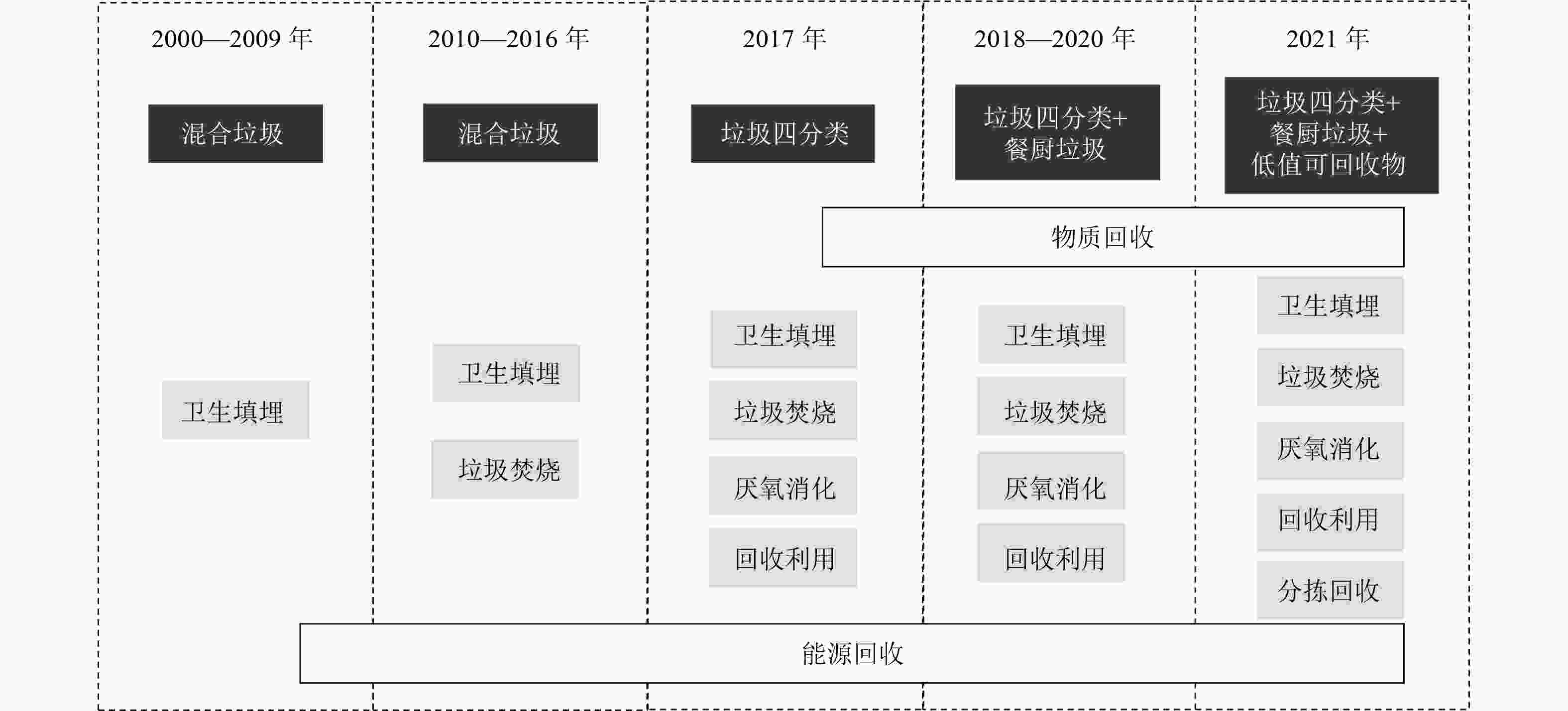
 下载:
下载:
